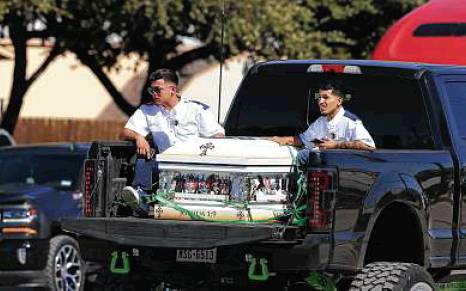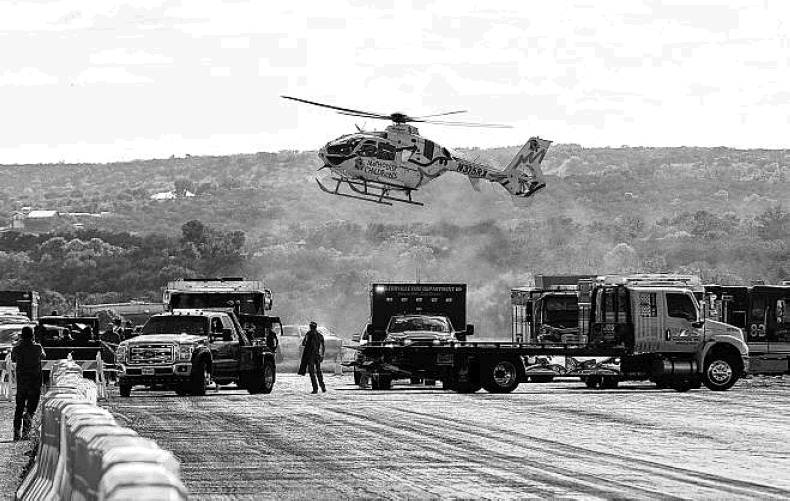Officials sanctioned drag race that turned deadly at Kerrville airport
By Brian Chasnoff, Jacob Beltran and Annie Blanks STAFF WRITERS
KERRVILLE — Tony Gallucci stood with his camera at the starting line of the race, snapping photos of every souped-up vehicle that had come to the Kerrville-Kerr County Airport to tear down a runway that had been turned into a spectator-lined drag strip.
There were 160 of them: Gleaming, hulking semis belching black smoke from their exhaust pipes. A silver Top Fuel dragster with rear tires that dwarfed the ones in front. A Funny Car with a beveled shell painted bright orchid-purple.
A former street racer turned freelance photographer, Gallucci, 67, had attended hundreds of similar events. At this one, dubbed Airport Race Wars 2 by Flyin’ Diesel Performance and Offroad, the Kerrville auto parts shop and airport tenant that had organized the event, Gallucci wasn’t even watching the faceoffs.
That is, until one car in particular — a steel-gray 1990 Ford Mustang, the words “Section Eight” scrawled across its front bumper — started screaming down the 1/8th-mile track.
“Something made me turn,” Gallucci said. “And I don’t know if it was him starting to wobble.”
What happened next the afternoon of Oct. 23 took mere seconds to unfold. But it left behind a scene of unthinkable devastation.
The Mustang lost control and roared straight into a crowd of spectators, who were unprotected by any barriers beyond the finish line. Directly across from the crash, Saundra Ellis was watching the race from the bed of a truck.
Smoke and dust obscured the carnage, Ellis said. But she can’t forget the sound that emerged from the haze.
“The part that I can’t get out of my head was the screaming,” said Ellis, 54, who works at the Hill Country Youth Ranch in nearby Ingram. “It was just one scream, constant. And it was just an utter terror scream. It was out of a horror movie.”
As police and paramedics sprinted toward the wreckage, car enthusiasts crouched over the injured who lay sprawled in the grass. One man, his body scratched and bloodied, held a black T-shirt to his bruised face. A toddler who had barely escaped serious injury sat slumped and saddened, his eyes cast downward.
Worst of all: Under the front left wheel of the smashed-up Mustang lay the motionless body of a 6-year-old boy.
The child — Daniel Trujillo-Jones, of Taylor — and an 8-year-old boy, Santiago Abel Martinez, of San Antonio, both were killed in the crash, along with Rebeca Cedillo Dias, 46, of Converse.
Santiago’s father, Abel Martinez, is a professional truck driver who had raced a semi earlier in the event. His family had come to support him in the race.
Rebeca was the boy’s aunt. The two had just stepped off a flatbed trailer to buy some cotton candy from a concession stand — Santiago loved sweets — when the Mustang crushed them, relatives said.
Three others remained hospitalized Friday: Daniel’s father, 26-year-old Chance Dean Jones, of Taylor, and his girlfriend, Mary Kate Walls, 27, of Taylor; and Michael Gonzales, 34, of Fort Worth, who was driving the Mustang.
Gallucci, who snapped images of the Mustang as white smoke poured from its tires and it careered toward the crowd, was wary of casting any blame for the tragedy. He called it “a freak accident.”
“There is no safe place in a race track,” he said. “Race tracks are inherently dangerous, period.”
Others were less forgiving.
Roy Anderson, a spectator and owner of an auto upholstery shop in nearby Ingram, feared the worst from the beginning.
“They had water barriers up to the finish line, and that was it,” said Anderson,
55. “Me and my wife had walked down before, to the end of the track and beyond. She was talking to me, and I said, ‘No, no, no. Pay attention to the cars right now because they’re coming our way. And there’s really nothing to protect us if one of them wipes out.’
“We’re talking about people — amateurs — and machinery that breaks down.”
County ‘all in’
On Sept. 13, Ross Dunagan, owner of Flyin’ Diesel, stood before Kerr County commissioners to discuss temporarily closing a runway at the county-owned airport to hold the race. Dunagan had organized a previous event at the airport in March.
Precinct 1 Commissioner Harley David Belew had one question.
“I just want to know if you’re going to race those 18-wheelers again this year,” the commissioner said.
“Yes, I did talk with them over the weekend,” Dunagan said. “They are coming back out.”
“Well, I’m all in then,” Belew said.
Attached to the commission agenda was a letter from Mary Rohrer, the airport manager, to the Texas Department of Transportation.
Rohrer wrote that the Kerrville-Kerr County Airport was “the only location that can accommodate the number of people that would like to participate in the racing and to observe the races in a safe and protected environment.”
Rohrer extolled the “economic impact” to Kerrville from “a great family style event” that would attract about 3,000 spectators from across the state. On safety, Rohrer wrote that officials had met after the event in March to develop a list of “lessons learned” to incorporate into the October race.
The plan included employing police officers and medical staff “if a problem should arise from a crash” and placing water-filled barriers on both sides of the track to protect spectators.
Aside from having volunteer firefighters on scene and the barriers along the race route, the county’s plan did not include any other safety measures to keep spectators safe, such as keeping people a reasonable distance from the runway or placing barriers past the end of the race course.
The county was careful to protect its airport runway pavement, promising to have a “Sealcoat Specialist” on hand at the event to address any problems that might arise from an accident or spill.
Safety waivers
The event organizer also assured the county that it would be free from any liability.
“Before anyone is allowed to enter the airport grounds we will have, at the gate, a waiver that every individual entering the premises is required to sign,” the agenda attachment read. “We want to ensure that the airport property and staff as well as our staff and company be free from liability.”
Anderson, one of the race attendees, said he signed the waiver but didn’t read it.
“They made everybody sign a waiver, but … you still expect it to be safe,” he said.
At the commissioners court meeting, County Judge Rob Kelly praised the safety measures that he and Dunagan had agreed to implement, calling his ties to the airport tenant “a very mutually beneficial relationship.”
Dunagan told the commissioners that he expected the race to generate even more revenue than the previous contest.
“Well, we like those good surprises,” Kelly said.
Neither Kelly nor Belew returned messages requesting comment.
In an interview, Precinct 4 Commissioner Don Harris suggested the race’s tragic outcome was unforeseeable.
“There’s never an event where we don’t figure out we can do something better,” Harris said.
The Mach 1 Group, an Austin-based public relations firm, answered questions from the Express-News addressed to Dunagan and Flyin’ Diesel.
“Safety was top of mind while planning the event,” the firm said in a statement. “While drag racing has its inherent dangers, we adhered to industry norms to put precautions in place to protect audience members. These precautions included briefing drivers on safety measures as well as setting up and monitoring barricades.”
“Throughout the race, spectators were repeatedly warned to stay behind the barriers,” the firm continued. “We are committed to being fully cooperative with all investigations into the accident.”
The group also said that it wouldn’t comment yet on what caused the 1990 Ford Mustang to lose control and crash into spectators.
‘No-prep’ track
At the first Airport Race Wars in March, a chain-link fence was all that separated the race course from spectators.
This month, Flyin’ Diesel had enhanced its safety precautions, extending orange and white barriers up and down the course. But the water-filled barriers stopped at the finish line. Spectators stretched beyond it on both sides of the two lanes where dragsters raced side by side.
Anderson, owner of the Ingram upholstery shop, said he paid $20 for a ticket and signed a waiver on the way in. He recalled Dunagan standing atop a trailer before the event, speaking to the drivers.
“He said, ‘Don’t do nothin’ crazy at the end of this eighth-mile, guys. If we have something bad happen, we might never have a race out here again.’ ”
Anderson and his wife sat close to the starting line. Before the fatal crash, he saw two near-wrecks occur. One car skidded sideways down the track; another knocked down some barriers, he said.
Then tragedy struck.
“I got up and looked down the track, and I was like, ‘Oh no. It just went into people. I was afraid of that.’ ”
Monte Tschirhart, of Rio Medina, raced a red Mustang in the event. Afterward, he was watching when the gray Mustang lost control.
“I knew that Mustang was kind of in trouble from the get-go,” Tschirhart said. “He’s just spinning the tires. He wasn’t getting any traction. That’s the name of the game. It’s just an unprepped track.”
A prepped track is sprayed with a compound to provide traction, he said.
The Mach 1 Group said such a compound could have damaged the airport’s runway.
“Since this event was taking place on a county owned airport runway, we would not have been able to make it a prepped track,” the firm said. “No-prep races are a way to simulate street racing but in a safer and controlled environment.”
After the crash, some said it had changed their perception of the risks involved in watching the sport.
“I feel a little bit responsible for supporting this thing,” Anderson said.
Ellis grew up in rural Virginia watching drag races — from bleachers.
“I’m torn,” she said. “We know going into it that there is a danger. But we don’t think about it. Up until what happened, it was fun. It was good. It was exciting.
“And unfortunately, am I ever going to look at races the same? No, I’m not.” bchasnoff@express-news.net jbeltran@express-news.net annie.blanks

